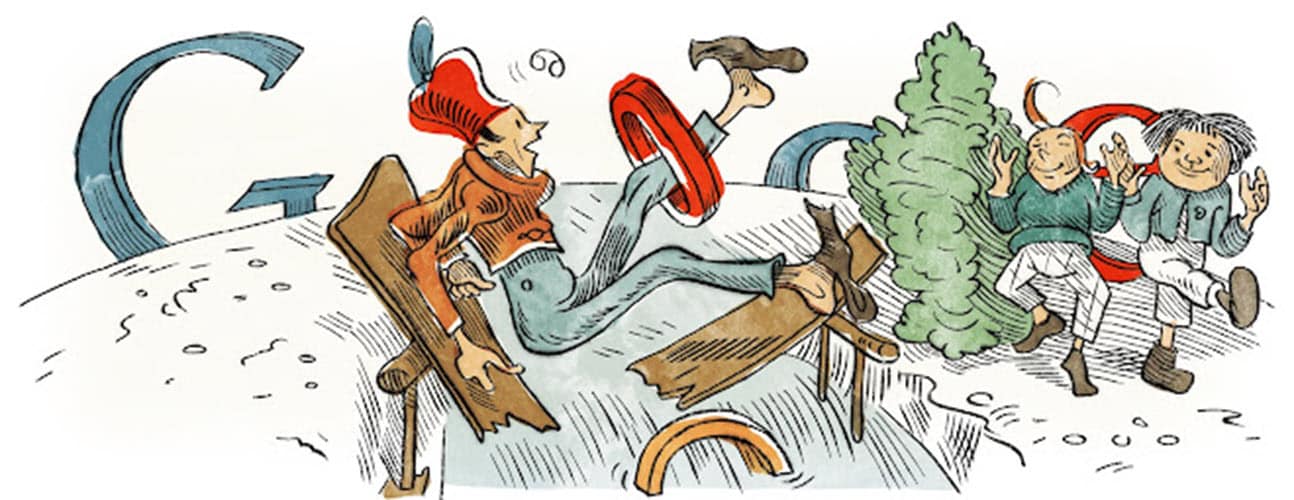Wilhelm Busch: The Father of the Graphic Novel

Image Courtesy: Google Doodle
Wilhelm Busch (14 April 1832 – 9 January 1908) was a German humorist, poet, illustrator, and painter. He published wildly innovative illustrated tales that remain influential to this day.
Life and Career
Wilhelm Busch was born on 14 April 1832, in Wiedensahl, a small town in the Kingdom of Hanover (now part of Germany). He grew up in a modest household, and his artistic talent was evident from a young age. He showed a keen interest in drawing and literature, and his parents encouraged his creative pursuits.
Busch attended school in Hanover and later studied mechanical engineering in Munich, but his true passion was art. He received formal artistic training at the Düsseldorf Academy, where he studied painting and drawing. He later moved to Antwerp, Belgium, to study under the renowned painter Gustave Wappers.
Busch’s breakthrough came in the mid-19th century when he started publishing his illustrated satirical stories in various magazines and newspapers. His works, characterized by their humorous and sometimes dark tone, often portrayed the follies and vices of society, including greed, hypocrisy, and stupidity. His illustrations were highly detailed and expressive, and his witty texts complemented his artwork, creating a unique and captivating style.
Busch’s most famous work is “Max und Moritz,” a humorous children’s story published in 1865. It tells the story of two mischievous boys who play pranks on their fellow villagers, which ultimately leads to their comeuppance. “Max und Moritz” is considered a pioneering work of comic art and is widely regarded as one of Busch’s masterpieces.
After the success of “Max und Moritz,” Busch continued to produce satirical works, often focusing on themes such as social criticism, politics, and religion. Some of his other notable works include “Die fromme Helene” (The Pious Helene) and “Plisch und Plum” (Plisch and Plum). Busch’s works were popular during his lifetime, and he gained a reputation as a talented humorist and illustrator. He died on 9 January 1908 at an age of 75 in Hanover, German Empire.
Award and Legacy
Wilhelm Busch’s contributions to German literature and art have been recognized with various awards and honors. Here are some notable awards and his legacy:
- Max and Moritz Prize: The Max and Moritz Prize is a prestigious German literary award named after Busch’s famous work “Max und Moritz.” Established in 1975, the award is presented every two years and recognizes outstanding achievements in the field of comics and graphic novels.
- Wilhelm Busch Medal: The Wilhelm Busch Medal is an award given by the German Academy for Humor and Satire. It was established in 1978 and is awarded annually to individuals who have made significant contributions to humor and satire in literature, art, or journalism.
- Wilhelm Busch Museum: The Wilhelm Busch Museum in Hanover, Germany, is dedicated to preserving and promoting Busch’s legacy. The museum houses a collection of his original artworks, manuscripts, and personal belongings, providing insights into his life and career. It serves as a cultural institution that celebrates Busch’s contributions to literature, art, and humor.
Wilhelm Busch’s legacy as a humorist, poet, and illustrator is significant and enduring. His innovative approach to storytelling, his sharp wit, and his astute observations of human nature have earned him recognition through awards and honors, and his works continue to be appreciated and studied today. His influence on literature, art, and popular culture, particularly in the field of comics and graphic novels, is evident, and the Wilhelm Busch Museum stands as a testament to his enduring legacy.
On 15 April 2012, Google celebrated Wilhelm Busch’s 180th Birthday with a doodle.
Observer Voice is the one stop site for National, International news, Sports, Editor’s Choice, Art/culture contents, Quotes and much more. We also cover historical contents. Historical contents includes World History, Indian History, and what happened today. The website also covers Entertainment across the India and World.

